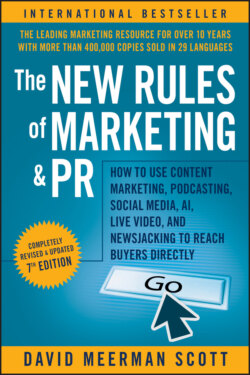Читать книгу The New Rules of Marketing and PR - David Meerman Scott, Kevin Nalty, Steve Garfield - Страница 14
Writing Like on a Blog, but in a Book
ОглавлениеBecause the lines between marketing and PR have blurred so much that the distinction is now virtually unrecognizable, the best online media choice is often not as obvious as it was in the old days. I had to organize the book by chapters for the various tools, including blogs, video, social networking, and so on. The truth is that all these techniques intersect and complement one another.
These online media are evolving very rapidly, and by the time you read these words, I’ll no doubt have come across new techniques that I’ll wish I could have put in the seventh edition. Still, I believe that the fundamentals are important, which is why Chapter 10 (where you’ll start to develop your own online marketing and PR plan) is steeped in practical, commonsense thinking.
The book is organized into three parts. Part I is a rigorous overview of how the web has changed the rules of marketing and PR. Part II introduces and provides details about each of the various media. Part III contains detailed how-to information and an action plan to help you put the new rules to work for your organization.
While I think this sequence is the most logical way to present these ideas, there’s no reason why you shouldn’t flip from chapter to chapter in any order that you please. Unlike a mystery novel, you won’t get lost in the story if you skip around. And I certainly don’t want to waste your time. As I was writing, I found myself wishing that I could send you from one chapter to another chapter with hyperlinks, like on a blog. Alas, a printed book doesn’t allow that, so instead I have included more old-fashioned references where I suggest you skip ahead or go back to review specific topics.
When I mention people and organizations, I frequently mention their Twitter IDs, which are preceded by the “@” sign. So if I were to reference my name and Twitter ID, you’d see it like this: David Meerman Scott @dmscott. This way, you can quickly learn more about the person or organization by checking them out on Twitter.
You’ll notice that I write in a familiar and casual tone, rather than the more formal and stilted voice of many business books. That’s because I’m using my “blog voice” to share the new rules with you. It’s how I like to write, and I believe it also makes things easier for you, the reader.
When I use the words company and organization throughout this book, I’m including all types of organizations and individuals. Feel free to mentally insert nonprofit, government agency, political candidate, church, school, sports team, legal firm, or other entity in place of company and organization. Similarly, when I use the word buyers, I also mean subscribers, voters, volunteers, applicants, and donors, because the new rules work for reaching all these groups. Are you a leader of a nonprofit organization that needs to increase donations? The new rules apply to you as much as to a corporation. Ditto for political campaigns looking for votes, schools that want to increase applications, consultants hunting for business, and churches seeking new members.
This book will show you the new rules and how to apply them. For the people all over the world interacting on the web, the old rules of marketing and PR just don’t work. Today, all kinds of organizations communicate directly with their buyers online. According to the International Telecommunications Union,2 an agency of the United Nations, 51.2 percent of the global population, or 3.9 billion people, were using the Internet at the end of 2018. Even more remarkably, there were 107 cell phone subscriptions for every 100 people in the world. Yes, there are more mobile phones than people in the world! So it’s no surprise that, in order to reach the individuals who would be interested in their organizations, smart marketers everywhere have altered the way they think about marketing and PR.
